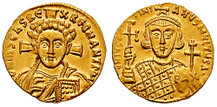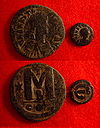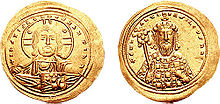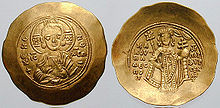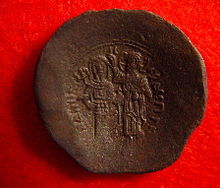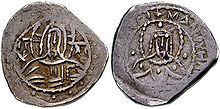- Byzantine coinage
-

Numismatics Terminology
 Portal
PortalCurrency Circulating currencies
Community currenciesAncient currencies Medieval currencies
Modern currencies-
Africa, The Americas,
Europe, Asia, Oceania
Production -
Mint, Designers
Exonumia Byzantine currency, money used in the Eastern Roman Empire after the fall of the West, consisted of mainly two types of coins: the gold solidus and a variety of clearly valued bronze coins. By the end of the empire the currency was issued only in silver stavrata and minor copper coins with no gold issue.[1]
Contents
Iconography
Early Byzantine coins continue the late Roman conventions: on the obverse the head of the Emperor, now full face rather than in profile, and on the reverse, usually a Christian symbol such as the cross, or a Victory or an angel (the two tending to merge into one another). The gold coins of Justinian II departed from these stable conventions by putting a bust of Christ on the obverse,[note 1] and a half or full-length portrait of the Emperor on the reverse. These innovations incidentally had the effect of leading the Islamic Caliph Abd al-Malik, who had previously copied Byzantine styles but replacing Christian symbols with Islamic equivalents, finally to develop a distinctive Islamic style, with only lettering on both sides. This was then used on nearly all Islamic coinage until the modern period.
The type of Justinian II was revived after the end of Iconoclasm, and with variations remained the norm until the end of the Empire.
In the 10th century so-called "anonymous folles" were struck instead of the earlier coins depicting the emperor. The anonymous folles featured the bust of Jesus on the obverse and the inscription "XRISTUS/bASILEU/bASILE", which translates to "Christ, Emperor of Emperors"
Byzantine coins followed, and took to the furthest extreme, the tendency of precious metal coinage to get thinner and wider as time goes on. Late Byzantine gold coins became thin wafers that could be bent by hand.
The Byzantine coinage had a prestige that lasted until near the end of the Empire. European rulers, once they once again started issuing their own coins, tended to follow a simplified version of Byzantine patterns, with full face ruler portraits on the obverse.
Denominations
The start of what is viewed as Byzantine currency by numismatics began with the monetary reform of Anastasius in 498, who reformed the late Roman Empire coinage system which consisted of the gold solidus and the bronze nummi. The nummus was an extremely small bronze coin, at about 8–10 mm, weight of 0.56 making it at 276 to the Roman pound[3] which was inconvenient because a large number of them were required even for small transactions.
New bronze coins, multiples of the nummus were introduced, such as the 40 nummi (also known as the follis), 20 nummi, 10 nummi, and 5 nummi coins (other denominations were occasionally produced). The obverse (front) of these coins featured a highly stylized portrait of the emperor while the reverse (back) featured the value of the denomination represented according to the Greek numbering system (M=40, K=20, I=10, E=5). Silver coins were rarely produced.
The only regularly issued silver coin was the Hexagram first issued by Heraclius in 615 which lasted till the end of the 7th century,[4][5] minted in varying fineness with a weight generally between 7.5 and 8.5 grams. It was succeeded by the initially ceremonial miliaresion established by Leo III the Isaurian in ca. 720, which became standard issue from ca. 830 on and until the late 11th century, when it was discontinued after being severely debased. Small transactions were conducted with bronze coinage throughout this period.
The gold solidus or nomisma remained a standard of international commerce until the eleventh century, when it began to be debased under successive emperors beginning in the 1030s under the emperor Romanos Argyros (1028–1034). Until that time, the fineness of the gold remained consistent at about 0.955–0.980.
The Byzantine monetary system changed during the 7th century when the 40 nummi (also known as the follis), now significantly smaller, became the only bronze coin to be regularly issued. Although Justinian II (685–695 and 705–711) attempted a restoration of the follis size of Justinian I, the follis continued to slowly decrease in size.
In the early ninth century, a three-fourths-weight solidus was issued in parallel with a full-weight solidus, both preserving the standard of fineness, under a failed plan to force the market to accept the underweight coins at the value of the full weight coins. The 11⁄12 weight coin was called a tetarteron (a Greek comparative adjective, literally "fourth-er"), and the full weight solidus was called the histamenon. The tetarteron was unpopular and was only sporadically reissued during the tenth century. The full weight solidus was struck at 72 to the Roman pound, roughly 4.48 grams in weight. There were also solidi of weight reduced by one siliqua issued for trade with the Near East. These reduced solidi, with a star both on obverse and reverse, weighed about 4.25 g.
Alexius I reforms
By the time of the Emperor Romanos Diogenis (1067–1071) the solidus had been debased to only roughly 15% gold content. Under Alexius I Comnenus (1081–1118) the debased solidus was discontinued and a gold coinage of higher fineness (generally .900-.950) was established, commonly called the hyperpyron at 4.45 grs.
The hyperpyron was slightly smaller than the solidus. It was introduced along with the electrum aspron trachy worth a third of a hyperpyron and about 25% gold and 75% silver, the billon aspron trachy or stamenon [6] valued at 48 to the hyperpyron and with 7% silver wash and the copper tetarteron and noummion worth 18 and 36 to the billon aspron trachy.[7]
Andronicus II reforms
During Andronicus II's reign he instituted a some new coinage based on the hyperpyron. They were the silver miliaresion or basilika at 12 to the hyperpyron and the billon politika at 96 per hyperpyron [8] along with the copper assaria, tournesia and follara[9] The basilikon was a copy of the Venetian ducat and circulated since 1304 for fifty years.[10]
The hyperpyron remained in regular issue and circulation until the 1350s, remaining in use thereafter only as a money of account. After 1400, Byzantine coinage became insignificant, as Italian money became the predominant circulating coinage.
These scyphate (cup-shaped) coins known as trachy were issued in both electrum (debased gold) and billon (debased silver). The exact reason for such coins is not known, although it is usually theorized that they were shaped for easier stacking.
1367 reform
During this last phase of Byzantine coinage gold issues were discontinued and a regular silver issue was commenced. The denomination was the Stavraton issued in 1, a half, an eighth[1] and a 16th of its value.[10][11] Also issued were the copper follaro and tornesse.[12]
Relative values
Anastasius I[13] (after. 495 C.E) Solidi Folles Half folles Decanummia Pentanummia Nummi Solidus 1 420 840 1680 3360 16,800 Follis 1⁄420 1 2 4 8 40 Half follis 1⁄840 ½ 1 2 4 20 Decanummium 1⁄1680 ¼ ½ 1 2 10 Pentanummium 1⁄3360 ⅛ ¼ ½ 1 5 Nummus 1⁄16,800 1⁄40 1⁄20 1⁄10 ⅕ 1 See also
Notes
- ^ The first portrait of Christ to appear on a coin may be on a gold solidus of Flavius Valerius Marcianus, a senator who came to rule the Eastern Roman, or Byzantine, Empire from A.D. 450-457. The coin appears to depict Christ bestowing a blessing on the Emperor of the East and his Empress, Aelia Pulcheria. But such images of Christ were far from popular until many years later.[2]
References
- ^ a b "The Story of Constantine XI; The Last Byzantine Emperor (1448-1453 AD)". 08 May 2008. http://www.harlanjberk.com/departments/articles/details.asp?inventorynumber=39&linenum=3.
- ^ Edward Banning, (Special to The Globe and Mail). Byzantine Coins Led Way In Using Christ's Image. The Globe and Mail. Saturday April 18, 1987, Page C20.
- ^ "The Story of Justinian". 08 May 2008. http://www.tulane.edu/~august/H303/currency/Justinian.htm.
- ^ "Greek and Roman Coins". 08 May 2008. http://www.cngcoins.com/Greek+and+Roman+Coins.aspx.
- ^ "Byzantine coins". 08 May 2008. http://www.doaks.org/CoinExhibition/CaseI/Case1_1_4.html.
- ^ The Period of the Gold Hyperpyron (12th-13th century)
- ^ http://www.tulane.edu/~august/H303/currency/Comnenian.htm. Dr. Kenneth W. Harl of the Tulane University
- ^ http://www.tulane.edu/~august/H303/currency/Comnenian.htm Kenneth W. Harl of the Tulane University
- ^ http://www.barber.org.uk/coins/byzantine3.html The Barber Institute of fine arts
- ^ a b "The Basilicon Episode (1304–ca. 1367)". 08 May 2008. http://www.doaks.org/CoinExhibition/history/History5Main.html.
- ^ http://www.dirtyoldcoins.com/gandinga/id/manuel2.htm Dirty old coins.com
- ^ "The Stavraton Period (14th–15th centuries)". 08 May 2008. http://www.doaks.org/CoinExhibition/CaseI/Case1_30_31.html.
- ^ http://www.tulane.edu/~august/H303/currency/Justinian.htm. Kenneth W. Harl of the Tulane University
Sources
- Grierson, Philip (1982), Byzantine coins, Taylor & Francis, ISBN 978-0-416713602, http://books.google.com/books?id=_kpOCsoUwksC
- Grierson, Philip (1999), Byzantine coinage, Dumbarton Oaks, ISBN 978-0-88402-274-9, http://www.doaks.org/publications/doaks_online_publications/byzcoins.pdf
- Hendy, Michael F. (1985), Studies in the Byzantine Monetary Economy c.300–1450, Cambridge University Press, ISBN 0-521-24715-2
- Kazhdan, Alexander, ed. (1991), Oxford Dictionary of Byzantium, Oxford University Press, ISBN 978-0-19-504652-6
External links
- Byzantine coinage by rulers
- Digital Library Numis (DLN) Online books and articles on Byzantine coins
- 3 Lists of Byzantine AE (and many other RIC lists of Roman AE coins) in Excel format to help you identify your coin
Currencies of the Byzantine Empire First period
(498 – ca. 700)Gold: Solidus · Semissis · Tremissis – Silver: Hexagram (from 615) – Copper: Follis · Half-follis · Decanummium · Pentanummium · NummusSecond period
(ca. 700 – 1092)Gold: Solidus or Nomisma (later Histamenon) · Tetarteron (from 960s) – Silver: Miliaresion (from 720) – Copper: FollisThird period
(1092 – ca. 1300)Gold: Hyperpyron – Electrum: Nomisma trachy aspron (Trikephalon/Manouelaton) – Billon: Aspron trachy (Stamenon) – Copper: Tetarteron · Half-tetarteronFourth period
(ca. 1300 – 1350s)Fifth period
(1367 – 1453)Related topics Categories:- Economy of the Byzantine Empire
- Coins of ancient Rome
- Numismatics
- Coins of the Byzantine Empire
Wikimedia Foundation. 2010.

